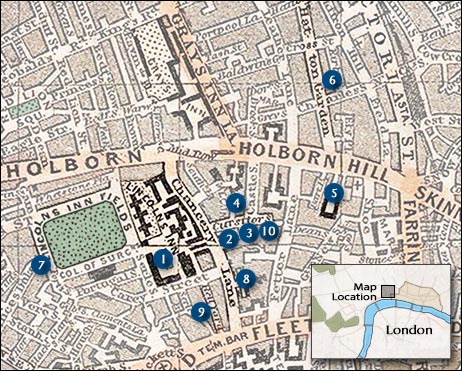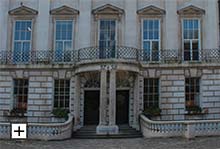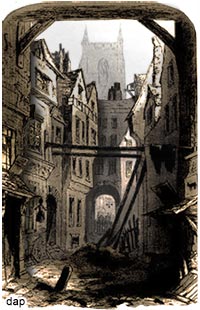The Charles Dickens Page
Charles Dickens'
Bleak House
Bleak House - Dickens' Masterpiece Lampoons the Court of Chancery
Bleak House - Published in monthly parts Mar 1852 - Sep 1853
Illustrations | Locations | Plot | Characters | More | Shop for the Book | Shop for the Video
Dickens' ninth novel, illustrated by Phiz, was intended to illustrate the evils caused by long, drawn-out suits in the Courts of Chancery. Dickens had observed the inner workings of the courts as a reporter in his youth and observes in Bleak House:
The one great principle of the English law is to make business for itself. There is no other principle distinctly, certainly, and consistently maintained through all its narrow turnings. Viewed by this light it becomes a coherent scheme and not the monstrous maze the laity are apt to think it. Let them but once clearly perceive that its grand principle is to make business for itself at their expense, and surely they will cease to grumble.
Bleak House is often considered one of Dickens' finest works (Davis, 1999, p. 35).
Plot
(contains spoilers)
The case of Jarndyce and Jarndyce, in the High Court of Chancery, has been going on for a long time. The current Jarndyce, John, owner of Bleak House, has little hope of gaining anything from it. On her aunt's death Esther Summerson is adopted by Jarndyce and becomes companions to his wards, Ada Clare and Richard Carstone. Carstone has hopes that the chancery case will make his fortune.
As the story unfolds it is revealed that Esther is the illegitimate daughter of Captain Hawdon and Lady Dedlock. When Sir Leicester Dedlock's lawyer, Tulkinghorn learns of this, and threatens to reveal the truth, he is murdered. Lady Dedlock flees and later dies at the gates of the cemetery where Hawdon lies buried.
John Jarndyce has fallen in love with Esther and asked her to marry him. She consents out of respect for Jarndyce but during the engagement she falls in love with Allan Woodcourt. When Jarndyce learns of her feelings for Allan he releases her from the engagement and she marries Woodcourt. The chancery case comes to a close with court costs eating up all of the estate. Carstone, who has married Ada, dies in despair.
Complete List of Characters:
Character descriptions contain spoilers
Bleak House Links:
- Bartleby.com
- Wikipedia - Bleak House
- Soft Soaping Dickens: Andrew Davies, BBC-1 and 'Bleak House' - Robert Giddings examines the popular belief that were Dickens alive today he would be writing soap operas for television
- Dickens and the Dinosaur - by Herb Moskovitz
Bleak House
Further Information
Locations in Bleak House

- Lincoln's Inn: Kenge and Carboys offices, Jarndyce and Jarndyce heard at Lincoln's Inn Hall, also at Westminster Hall
- Cursitor Street: Sol's Arms Tavern
- Cursitor Street: Krook's Rag and Bottle Shop - Miss Flite, Gridley, Nemo (Capt Hawdon), and Tony Jobling (Weevle) residence
- Cooks Court: Snagby's Law Stationer Shop
- Thavie's Inn - Jellyby's home
- Hatton Garden - Jellyby's home after bankruptcy
- Lincoln's Inn Fields: Tulkinghorn's residence
- Symond's Inn: Vholes' office, Richard and Ada's residence after marriage
- Bell Yard: Neckett's
- Cursitor Street: Coavinses Sponging House
Before Sherlock Holmes there was Inspector Bucket

Charles F. Field
In Bleak House Charles Dickens introduced one of the first detectives in English Literature: Inspector Bucket. Hired by lawyer Tulkinghorn to inquire into Lady Dedlock's secret past, Bucket later investigates Tulkinghorn's murder. Dickens based Bucket on real life detective Charles F. Field, a member of London's new police force (Slater, 2009, p. 313). Dickens wrote several stories featuring Field (sometimes under the name of Wield) in his weekly journal Household Words, including On Duty with Inspector Field (Household Words, 1851, 265).
Court of Chancery
The Court of Chancery was founded during the reign of Richard II and in Dickens' time was a model of inefficiency. Properties tied up 'in Chancery' were not financially accessible to possible beneficiaries. The court was presided over by the Lord Chancellor, disputants in Chancery cases used solicitors to state their case to hired barristers who presented them in court (Wikipedia). In Bleak House Richard Carstone hires Vholes as his solicitor in the Jarndyce and Jarndyce Chancery case.
Was the Thellusson case the original for Jarndyce? You decide...
James Thellusson makes a compelling argument that his ancestors' Chancery case was the original for Dickens' famous court battle.
St. Albans
Charles Dickens located John Jarndyce's Bleak House near the old Roman town of St. Albans in Hertfordshire, about 20 miles north of London (Google Map).
Dame Durden
One of the endearing names given to Esther Summerson when she takes over the household keys of Bleak House. The name comes from a traditional song and became a common term to refer to a housewife (encyclopedia.com).
Dame Durden kept five serving girls
To carry the milking pail;
She also kept five labouring men
To use the spade and flail.
'Twas Moll and Bet, and Doll and Kate, and Dorothy Draggletail,
And John and Dick, and Joe and Jack, and Humphrey with his flail.
'Twas John kiss'd Molly,
And Dick kiss'd Betty,
And Joe kiss'd Dolly,
And Jack kiss'd Katty,
And Dorothy Draggletail
,
And Humphrey with his flail,
And Kitty was a charming girl to carry the milking pail.
Dame Durden in the morn so soon
She did begin to call:
To rouse her servants, maids and men,
She then began to bawl.
Twas Moll and Bet
'Twas on the morn of Valentine,
The birds began to prate,
Dame Durden's servants, maids and men,
They all began to mate.
Twas Moll and Bet
(Library of Congress)
Mr Snagsby - Law Stationer
Before the advent of copy machines copies of law documents were made by hand. Mr Snagsby employs law-writers like Nemo to maticulously copy law documents. His office also sells the tools of the law trade:
On the eastern borders of Chancery Lane, that is to say, more particularly in Cook's Court, Cursitor Street, Mr Snagsby, law-stationer, pursues his lawful calling. In the shade of Cook's Court, at most times a shady place, Mr Snagsby has dealt in all sorts of blank forms of legal process; in skins and rolls of parchment; in paper--foolscap, brief, draft, brown, white, whitey-brown, and blotting; in stamps; in office-quills, pens, ink, India-rubber, pounce, pins, pencils, sealing-wax, and wafers; in red tape and green ferret; in pocket-books, almanacs, diaries, and law lists; in string boxes, rulers, inkstands--glass and leaden--pen-knives, scissors, bodkins, and other small office-cutlery; in short, in articles too numerous to mention (Bleak House, p. 127).
 Bleak House
Bleak House
(2005) DVD
Gillian Anderson, Anna Maxwell Martin, Denis Lawson
Spontaneous Human Combustion
![]() Charles Dickens sparked controversy in Bleak House when he has rag and bone dealer Krook die by spontaneous human combustion, a phenomenon where the human body catches fire as a result of heat generated by internal chemical action. Although scientists have denied the existence of this phenomenon, supposed cases of spontaneous human combustion are still reported today.
Charles Dickens sparked controversy in Bleak House when he has rag and bone dealer Krook die by spontaneous human combustion, a phenomenon where the human body catches fire as a result of heat generated by internal chemical action. Although scientists have denied the existence of this phenomenon, supposed cases of spontaneous human combustion are still reported today.
Charles Dickens' life during the serialization of Bleak House
Mar 1852 - Sep 1853Dickens' age: 40-41
March 1852
Son Edward Bulwer Lytton (Plorn) Dickens born (Slater, 2009, p. 344-345).
Summer 1852
Dickens' amateur acting troupe performing Edward Bulwer-Lytton's Not so Bad as We Seem throughout England for the benefit of the Guild of Literature and Art (Slater, 2009, p. 330-331).
February 1853
Becomes involved in a controversy concerning spontaneous combustion, from which Krook dies in the novel. George Henry Lewes argued that the phenomenon was a scientific impossibility, Dickens maintained that it could happen (Slater, 2009, p. 348-349).
June 1853
Seriously ill with a recurrence of a childhood kidney complaint. Bedridden for six days, he then went to Boulogne, France to fully recover (Slater, 2009, p. 355).
August 1853
Celebrates finishing the novel with a banquet in Boulogne. In attendance were his publishers Bradbury and Evans, friends Mark Lemon, John Forster, William Henry Wills, and Wilkie Collins (Slater, 2009, p. 359-360).
September 1853
The Death of Jo
Jo, attended by his friend, Dr Allan Woodcourt, tries to recite a prayer as life slips away:
'It's turned very dark, sir. Is there any light a-comin'?'
'It is coming fast, Jo.'
Fast. The cart is shaken all to pieces, and the rugged road is very near its end.
'Jo, my poor fellow!'
'I hear you, sir, in the dark, but I'm a–gropin– – a–gropin' – let me catch hold of your hand.'
'Jo, can you say what I say?'
'I'll say anythink as you say, sir, for I knows it's good.'
'Our Father.'
'Our Father! Yes, that's wery good, sir.'
'Which art in heaven.'
'Art in heaven––is the light a-comin', sir?'
'It is close at hand. Hallowed be Thy name.'
'Hallowed be–Thy––'
The light is come upon the dark benighted way. Dead!
Dead, your majesty. Dead, my lords and gentlemen. Dead, right reverends and wrong reverends of every order. Dead, men and women, born with heavenly compassion in your hearts. And dying thus around us every day (Bleak House, p. 649).
Tulkinghorn's Chambers
 Charles Dickens modeled Mr. Tulkinghorn's house on the house of his friend, and future biographer, John Forster. It is located at no. 58 Lincoln's Inn Fields (See number 7 on map at left).
Charles Dickens modeled Mr. Tulkinghorn's house on the house of his friend, and future biographer, John Forster. It is located at no. 58 Lincoln's Inn Fields (See number 7 on map at left).

